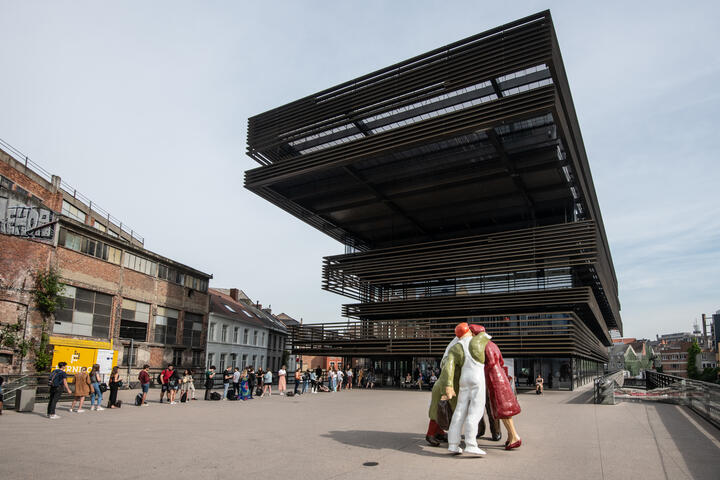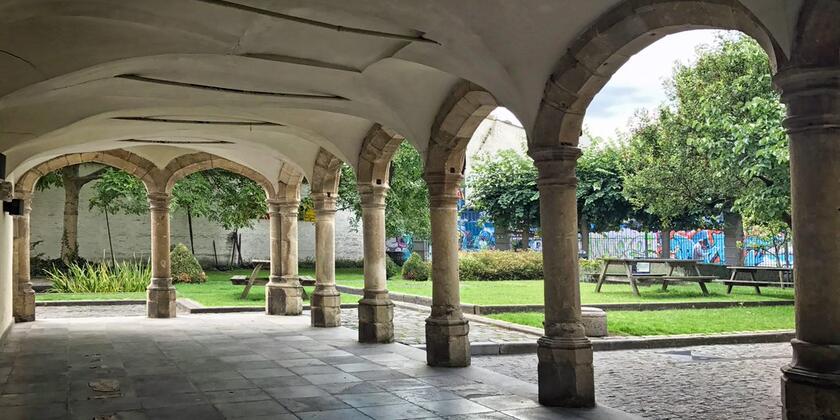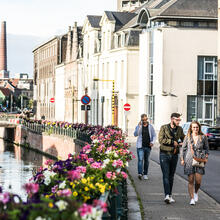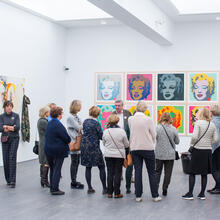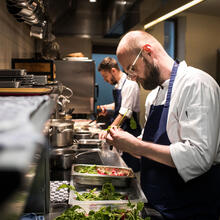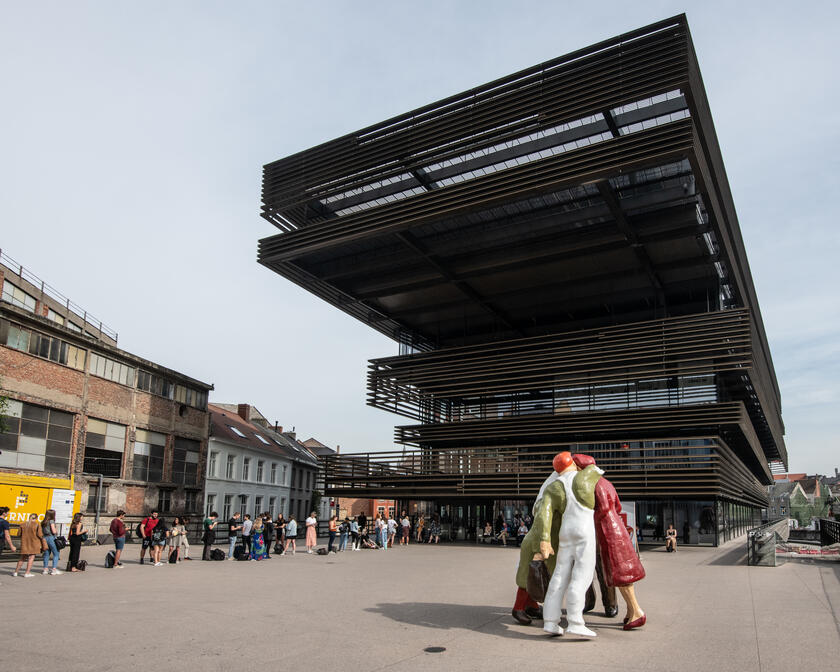
You don’t necessarily have to go to a museum to enjoy art in Ghent. You'll discover art in public places on this walk through the city centre. These artworks were created on the initiative of various commissioners, such as the city of Ghent, Ghent University or private individuals, but you can see them all free of charge. Some of these pieces elicit admiration, while others provoke discussion, but that is inherent in Ghent's DNA! Enjoy!
2,3 km - 3000 steps
‘The Sculpture of Human Rights’ by visual artist MaRf.
You can discover the first piece of art behind the Castle of the Counts, in the middle of the lawn: the Sculpture of Human Rights by visual artist MaRf. Two rocks that Nelson Mandela worked on Robben Island have been used in the pedestal of the statue of liberty.
Tip. The first stone of the Castle of the Counts was laid in 1180. This sculpture may soon have to make way for the construction of the new visitor centre, which is currently the subject of much discussion.
‘Ai Nati Oggi’ (2011) by Italian artist Alberto Garutti
Return to Sint-Veerleplein square and look for the 3 lamp posts on the corners of the square. Perhaps you wouldn’t think so, but these lamp posts are also a work of art!
Italian artist Alberto Garutti pays tribute to the newborn babies of Ghent with “Ai Nati Oggi” (to those born today) (2011). The artwork is connected to the maternity wards of Ghent's hospitals. The light goes on for a little while when parents push a button in the maternity ward. The street lighting is on during the night. When a baby is born, the light goes out for a short while. This artwork was originally located on Vrijdagmarkt square for the 2000 ‘Over the Edges’ festival.

‘The human bird’ by artist Jeffrie
Walk across the Hoofdbrug bridge, across the Lievekanaal canal, and turn right into Jan Breydelstraat. Turn right at the end and walk down Korenlei until you reach Ravensteinstraat 12, where you can see Jeffrie’s The Human Bird in the garden. Many ‘people’s wishes’ were written down and buried underneath the statue.
Abstract artwork by Maurits Witdouck
Cross Sint-Michielsplein square and turn right into Onderbergen, until you reach the front yard of the Pand building, where you can spot Maurits Witdouck’s abstract work that refers to the intertwining of Ghent University’s 11 faculties.
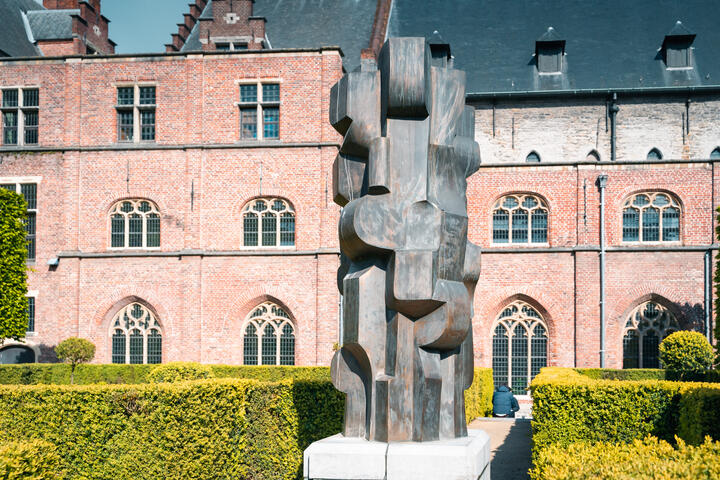
"The Blue Birds" by Maurice Maeterlinck
Walk straight ahead and turn left around the corner. Stop for a moment on the bridge. By day, you can see white origami birds in the tree on your left, but this artwork truly shines once the sun has set, especially in its reflection in the Lys river. It is part of the 'Ghent by Night' walk. This light installation is known as ‘The Blue Birds’. It is inspired by a fairy tale by Nobel Prize for Literature winner Maurice Maeterlinck called ‘L’oiseau bleu’. Its central theme is the pursuit of happiness, which is symbolised by a small blue bird. French design studio Pitaya created the artwork for the 2012 Light Festival, and the city of Ghent bought it in 2016.
More information about Maeterlinck can be found on: Maurice Maeterlinck | Stad Gent
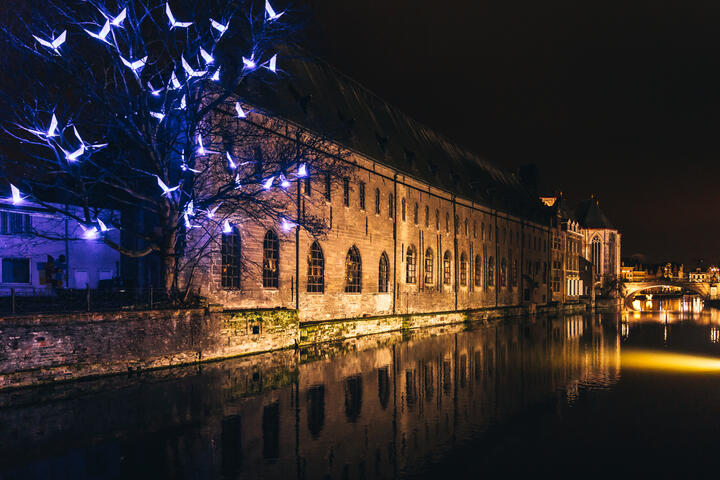
‘The Ghent Altarpiece’ by Belgian artist Bart Smeets (SM8S)
Turn left at the end of the bridge and walk down Predikherenlei until you reach Jan van Stopenberghestraat. You’ll see the large 2014 graffiti titled ‘The Ghent Altarpiece’ by Belgian artist Bart Smeets/Smates/SM8S on your right. The mural was created at the request of the Tourist Office following the Ghent premiere of George Clooney’s film ‘The Monuments Men’.
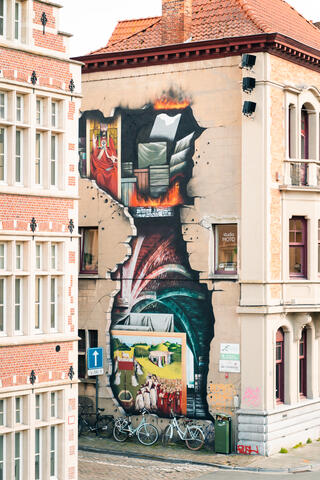
‘Broche’ (2017) by Turkish artist Ayşe Erkmen & HD400 (2017) by Belgian artist Ann Veronica Janssens
When you enter Korenmarkt square, you'll immediately notice 2 large vertical artworks: Broche and HD400.
- Turkish artist Ayşe Erkmen’s 2017 artwork ‘Broche’ is a 20 metre high gold chain, whose links refer to the gothic windows of the surrounding medieval buildings.
- Belgian artist Ann Veronica Janssens’ 2017 artwork ‘HD400’ refers to the H profile, which is a support beam used in modern buildings, and to North Sea Port’s metal industry.
They form each other’s counterpart by referring to the inner city's old buildings on the one hand, and the city's new buildings on the other.
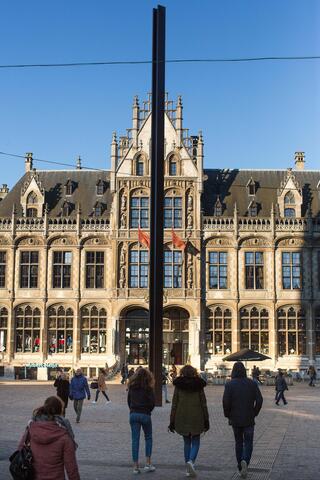
‘The Virgin’ (2014) by Belgian artist Michaël Borremans
Walk through the Klein Turkije street to Goudenleeuwplein square and take a look at the bell frame. Above the lift door, you can see ‘The Virgin' (2014) by Belgian artist Michaël Borremans. The rays from the young woman’s eyes are a reference to the Holy Spirit’s rays in the middle panel of the Ghent Altarpiece.
Tip: The City Pavilion, which was built in 2012, is very nearby. It’s based on an award-winning design by architects Robbrecht, Daem and Marie-José Van Hee. Ghentians wouldn’t be Ghentians if they hadn’t immediately renamed the city hall the ‘Sheep Pen’, thereby expressing their disapproval of the modern construction in the old city centre.
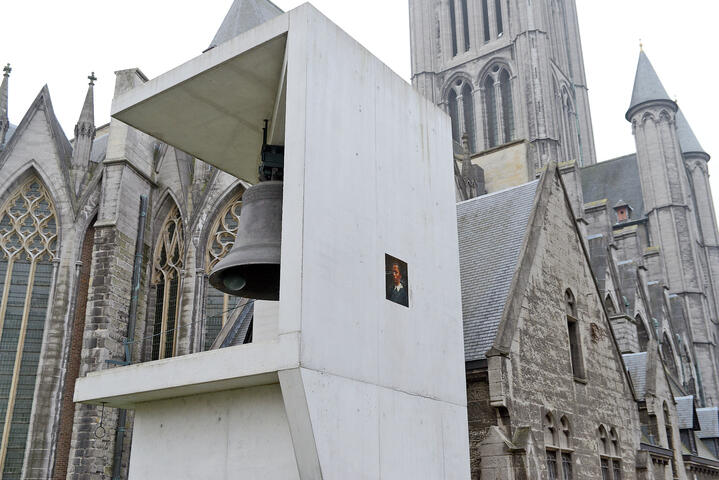
Fountain of the Kneeling (1937) by Belgian artist Georges Minne
Go down the steps to the little park next to the Belfry. The Fountain of the Kneeling (1937) by Belgian artist Georges Minne can be found on the Green. The people of Ghent have given this sculpture the nickname 'The Pissers'.
More on George Minne: http:/georgeminne.vlaamsekunstcollectie.be/nl/biografie
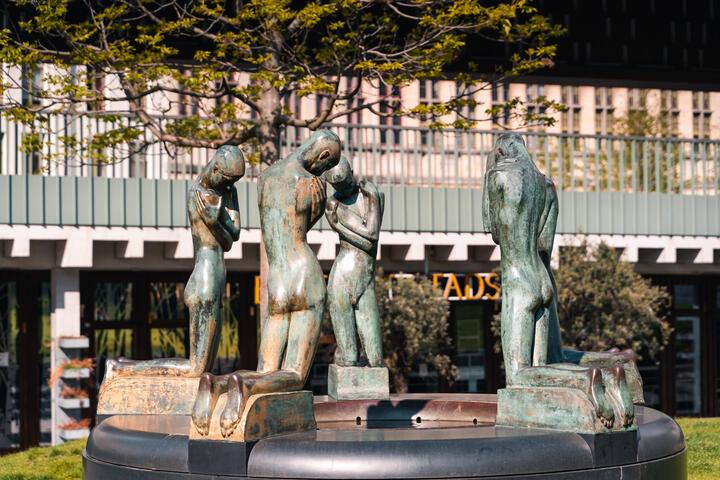
Moresca dancers (1992) by Belgian artist Walter De Buck
Walk up to Cataloniëstraat. You can see Belgian artist Walter De Buck’s Moresca dancers (1992) on the Mason’s Guild Hall. Moriscos were 16th-century Spanish Muslims who were forced to give up their profession and become Christians. The only job they were allowed to perform was dancing for the military.
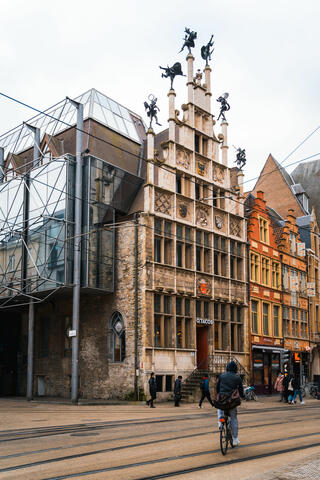
‘When I was little and lived under the table’ by Ghent ceramist MaRf
Walk past the Belfry and turn left on Sint-Baafsplein square. Almost at the far corner of the Cloth Hall, you’ll see ‘When I was little and lived under the table’. This bronze sculpture was made by Ghent ceramist Marf and was inspired by a poem by Roel Richelieu van Londerzeele.
Turn around and look at the tower of St Bavo's Cathedral. Belgian artist Kris Martin's 2011 stainless steel crucifix stands at 113 metres. The horizontal beam of the crucifix resembles 2 arms folded in front of the face of the Christ figure. During sunrise, the shining metal reflects the sunlight.
Walk until you reach the entrance of the Cathedral. On your left, you can see Marf's bronze scale model with braille explanations.
Tip. Two more works can be discovered in the Cathedral: Wim Delvoye’s ‘OPUS’ is right above your head when you enter the building. The 1432 Adoration of the Mystic Lamb by the Van Eyck brothers can be found here as well.
‘Mystic Leaves’ (2001) by American artist Jessica Diamond
Walk via Lange Kruisstraat, Kalandeberg and Kouterdreef and look for 18 bronze leaves scattered around Kouter square. The work is called ‘Mystic Leaves’ (2001) and was created by American artist Jessica Diamond. The bronze leaves are a reference to the plants depicted on the Ghent Altarpiece. If you look closely, you can discover the names of the plants in the nerves.
Tip: Every Sunday, there is a colourful flower market on Kouter square.

Mural (2005) by Belgian artist Jan Van Imschoot
Walk to Brabantdam. When you reach François Laurentplein square, you’ll see Jan Van Imschoot’s 2005 Mural on your right. The artist illustrates his love for historical scenes and Ghent's forgotten stories.
Sculpture group ‘The Passers-by’ (2017) by Belgian artist Michaël Borremans
Via Kuiperskaai you’ll eventually reach Miriam Makebaplein square, in front of the De Krook library. This where you can find the sculpture group titled ‘The Passers-by’ (2017) by Belgian artist Michaël Borremans. It illustrates the library's functions a place for reading, learning and exchanging knowledge. And gossip. ;-)
Tip: De Krook library is an architectural interaction between light and shadow. The library was a collaboration between architects Klaas Goris and Ralf Coussée and the Catalan firm of Aranda Pigem Vilalta Arquitectes. The new library opened its doors in March 2017.
